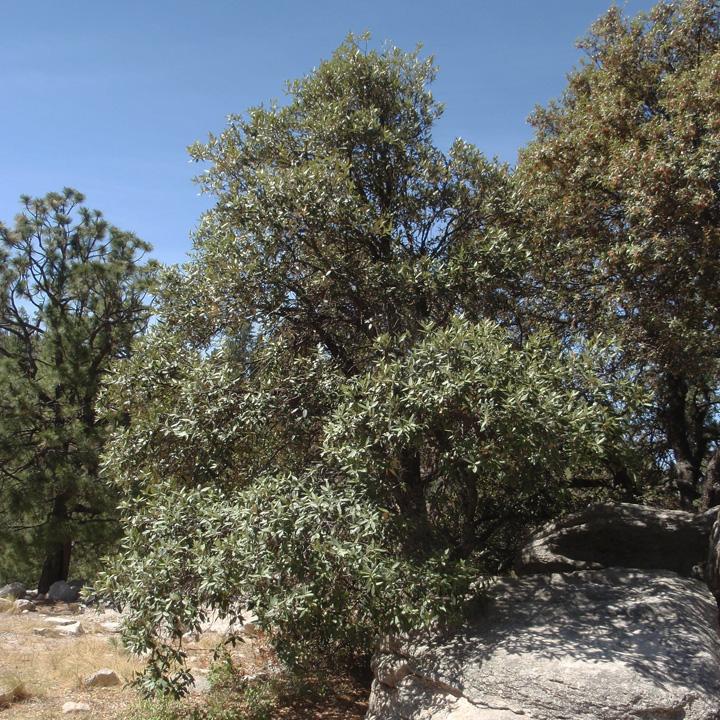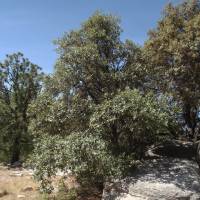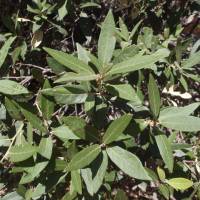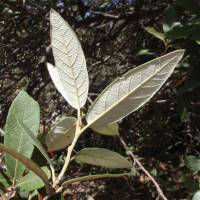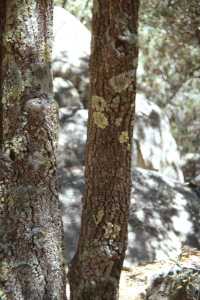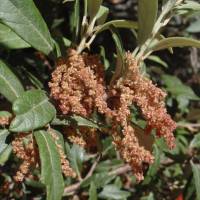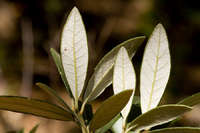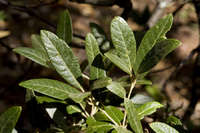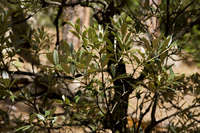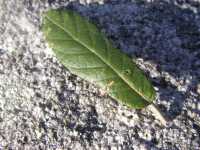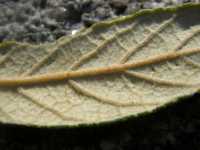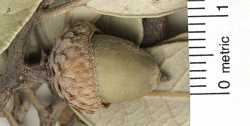Trees or shrubs , evergreen, to 10 m. Bark black, deeply furrowed. Twigs dark reddish brown, 1.5-3 mm diam., pubescent. Terminal buds light chestnut brown, ovoid, 2.5-4.5 mm, glabrous except for ciliate scale margins, occasionally with tuft of hairs at apex. Leaves: petiole 1.5-13 mm, densely pubescent. Leaf blade narrowly ovate to ovate or elliptic, 45-120 × 15-40 mm, base cuneate to rounded, margins strongly revolute, entire or spinose with up to 11 awns, apex acute to attenuate; surfaces abaxially densely tawny- or white-tomentose, adaxially noticeably rugose, glabrous. Acorns annual or biennial; cup deeply saucer- or cup-shaped, 4.5-7 mm high × 6-13 mm wide, covering 1/3 nut or less, outer surface pubescent to sparsely puberulent, inner surface pubescent to floccose, scales appressed, blunt; nut ellipsoid to oblong, 8-16 × 5-10 mm, glabrous, scar diam. 2.5-5.5 mm.
Flowering spring. Common in moist canyons and on ridges; 1500-2700 m; Ariz., N.Mex., Tex.; n Mexico.
Quercus hypoleucoides reportedly hybridizes with Q . gravesii ( Q . × inconstans E. J. Palmer [= Q . livermorensis C. H. Muller]) (see C. H. Muller 1951). Several specimens from Pima County, Arizona, fall outside the range of typical Q . hypoleucoides , suggesting hybridization with the Mexican Q . mcvaughii Spellenberg (R. Spellenberg 1992).
Plant: tree; to 10 m high, the bark dark blackish-gray; young twigs woolly, dark reddish-brown beneath hairs, becoming glabrous with age, the older twigs gray, more or less smooth
Leaves: unlobed, lanceolate to elliptic, 4-11 cm long, 0.8-3 cm wide, 3-5 times as long as wide, densely whitish woolly with stellate hairs beneath, glabrous or subglabrous above, persisting more than 1 year; stellate hairs of lower leaf surface with 10 or more arms; apex acute to acuminate, often mucronate; base acute to obtuse, sometimes oblique; petiole 3-11 mm long, woolly, later glabrescent; midvein raised above, prominent below; lateral veins ca. 9-15, impressed slightly above, prominent below; secondary venation impressed, often obscured by hairs below; blade coriaceous, dark green above, whitish (because of hairs) below; margin entire or less often serrate-dentate
INFLORESCENCE: staminate flowers in aments; pistillate flowers solitary or in groups on spikes, these sometimes abbreviated, each pistillate flower with a separate involucre
Flowers: mostly wind-pollinated, unisexual, the perianth much reduced or absent; staminate flowers in heads or aments, the perianth greenish, the stamens 4-6; pistillate flowers usually tricarpellate, solitary or in clusters of about 3 or more, subtended individually or in groups by an involucre that develops into a woody cupule enclosing or subtending the mature fruit(s)
Fruit: ACORNS 1.5-2 cm long, maturing after second summer; cap ca. 8 mm long, ca. 12 mm wide, woolly within and without; scales not much thickened basally; nut-shell woolly within
Misc: In oak and conifer forests; 1100-2700 m (3600-9000 ft); Apr-Jun (young fruits present at any time, mature fruits Aug-Nov)
REFERENCES: Landrum, Leslie R. Fagaceae. 1994. J. Ariz. - Nev. Acad. Sci. Volume 27, 203-214
Common Name: silverleaf oak
Duration: Perennial
Nativity: Native
Lifeform: Tree
General: Tree to 10 m tall, bark dark blackish-gray, young twigs woolly, dark reddish-brown beneath hairs, becoming glabrous with age, older twigs gray, more or less smooth.
Leaves: Unlobed, lanceolate to elliptic, 4-11 cm long, 0.8-3 cm wide, 3-5 times as long as wide, densely white woolly with stellate hairs beneath; persisting more than one year; leathery; apex acute, often mucronate, base acute to obtuse, petiole 3-11 mm long, woolly, later glabrescent; midvein raised above, prominent below; dark green above; margin entire or serrate dentate.
Flowers: Staminate flowers in slender aments, perianth 4-7 lobed; stamens 4-12; pistillate flowers solitary or in clusters 2 or 3; ovary inferior.
Fruits: Acorns 1.5-2 cm long, maturing after the second summer; cap 8 mm long, 12 mm wide, woolly within and without, scales not much thickened basally; nut shell woolly within.
Ecology: Found in canyons, woodlands or in the grasslands from 3,500-9,000 ft (1067-2743 m); flowers April-June.
Notes: Distinctive with its acute tip and the white undersides.
Ethnobotany: Unknown, but other species in the genus have many uses.
Etymology: Quercus is the classical Latin word for oak, thought to be derived from Celtic quer, fine, and cuez, tree, while hypoleucoides means white or pale beneath.
Synonyms: None
Editor: SBuckley, 2010


